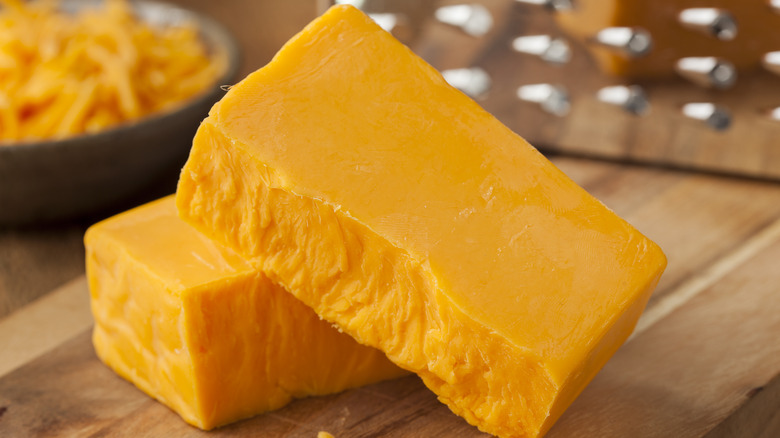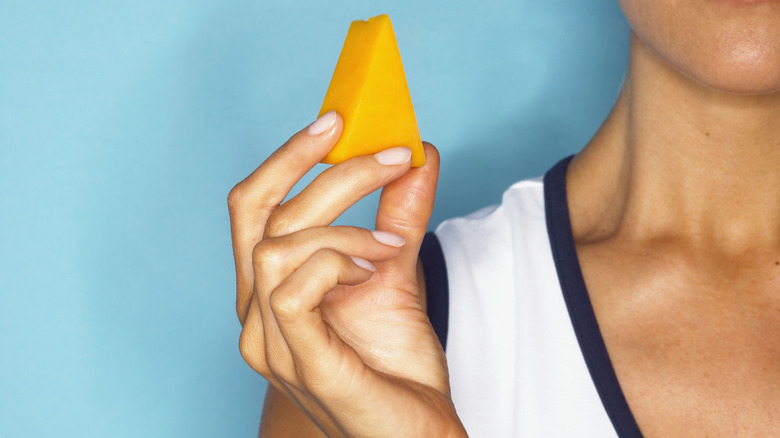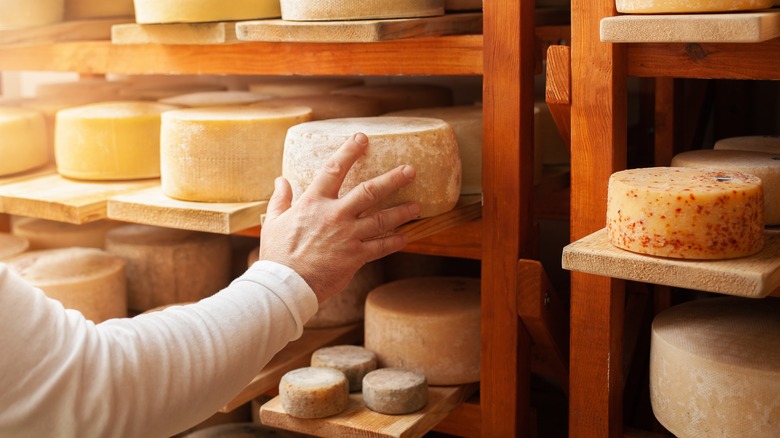How Cheddar Gets That Bright, Glowy Orange Color
There aren't many cheeses more iconic than a bright orange wedge of cheddar. After all, cheddar is one of the best cheeses to use for that mac and cheese recipe. But how exactly does cheddar (some cheddar, anyway) get that signature sunny hue? Well, the answer — at least for current batches of cheddar — is simple: It's dyed. That's right, the only difference between orange and white cheddar is that the orange version is dyed. Although some diners have a preference for one variation of cheddar over the other, there is usually no difference in taste. However, this was not always the case.
Centuries ago, that yellow-orange hue was a natural occurrence. The orange color was due to the beta-carotene-rich diet of the dairy cows once used to produce cheddar. This cheese was highly prized for its quality and taste. And many dairies, in hopes of capitalizing on cheddar's reputation, began dyeing their cheese with natural colorings such as saffron. The practice of dyeing cheddar remains common, even after the source of the color became outdated.
Currently, one of the most popular ways for cheddar to achieve its orange color is the use of annatto, a natural food coloring that comes from the seeds of an achiote tree, which is native to South America. Other dyes are also used, such as paprika or artificial dyes. However, this practice of cheese dyeing does not impact the flavor of cheddar and is typically an aesthetic choice.
A long history of the big cheese
So, how did orange become the default color for cheddar? Well, it starts — like all cheeses do — with the cow. In centuries past, many dairies in England raised and bred Jersey and Guernsey cows, two breeds that produced milk with a richer color than the usual white milk we know now, due to the beta-carotene in their diet. The cheese produced from this milk often had a naturally yellow or orangish pigment that has become inextricably linked to cheddar cheese. Originally, this color was not universal to all cheddars but rather stood as an indication of a higher quality cheese.
But in the 17th century, dairy farmers began to skim the pigmented cream from the milk and sell it, causing the milk — which was used to make the cheese — to lose its pigment in the process. This led to cheesemakers fudging the color of their cheese, often adding natural dyes to achieve the signature yellow-orange. This practice has continued through history, and even past its origins in 17th-century cheesemaking, the once grass-fed color has become iconic. But white cheddar, the undyed version of cheddar cheese, has grown in popularity in recent years; particularly because it doesn't contain the dyes that yellow cheddar does, giving it a reputation as a more "natural" food. However, it is important to note that the dyes used in cheddar have been tested for safety, so if you prefer to eat the orange stuff, there's no need to worry.
What makes a difference in flavor
The difference between white and orange cheddar is primarily aesthetic. While some cheese lovers have a preference for one over the other, the color of your cheese does not play a part in the various flavor profiles of cheddar. With that being said, there are a few things that do play a part in the various versions of cheddar on the market today.
Perhaps the biggest influence is the aging process that affects the taste of sharp cheddar cheese. Milder cheddars tend to age for a shorter time, whereas sharp cheddars tend to age for at least a few years. Cheddar is typically aged for about a year to 18 months. Some cheddars are aged for six years or even longer, producing a much sharper flavor.
Other factors include the quality of the milk used in the cheese, the bacteria used to start the culturing process, and the moisture content of the final product. All of these factors influence your cheddar's taste far more than its color does. However, not all cheddars are built (or cultured) equally, and some cheddars can vary widely in taste, smell, and texture. Blue cheddar cheese, for example, contains a vein of blue cheese mold that gives your cheddar a distinct earthy taste that suffuses. Otherwise, choosing white or orange cheddar is a matter of aesthetics more than anything else.


